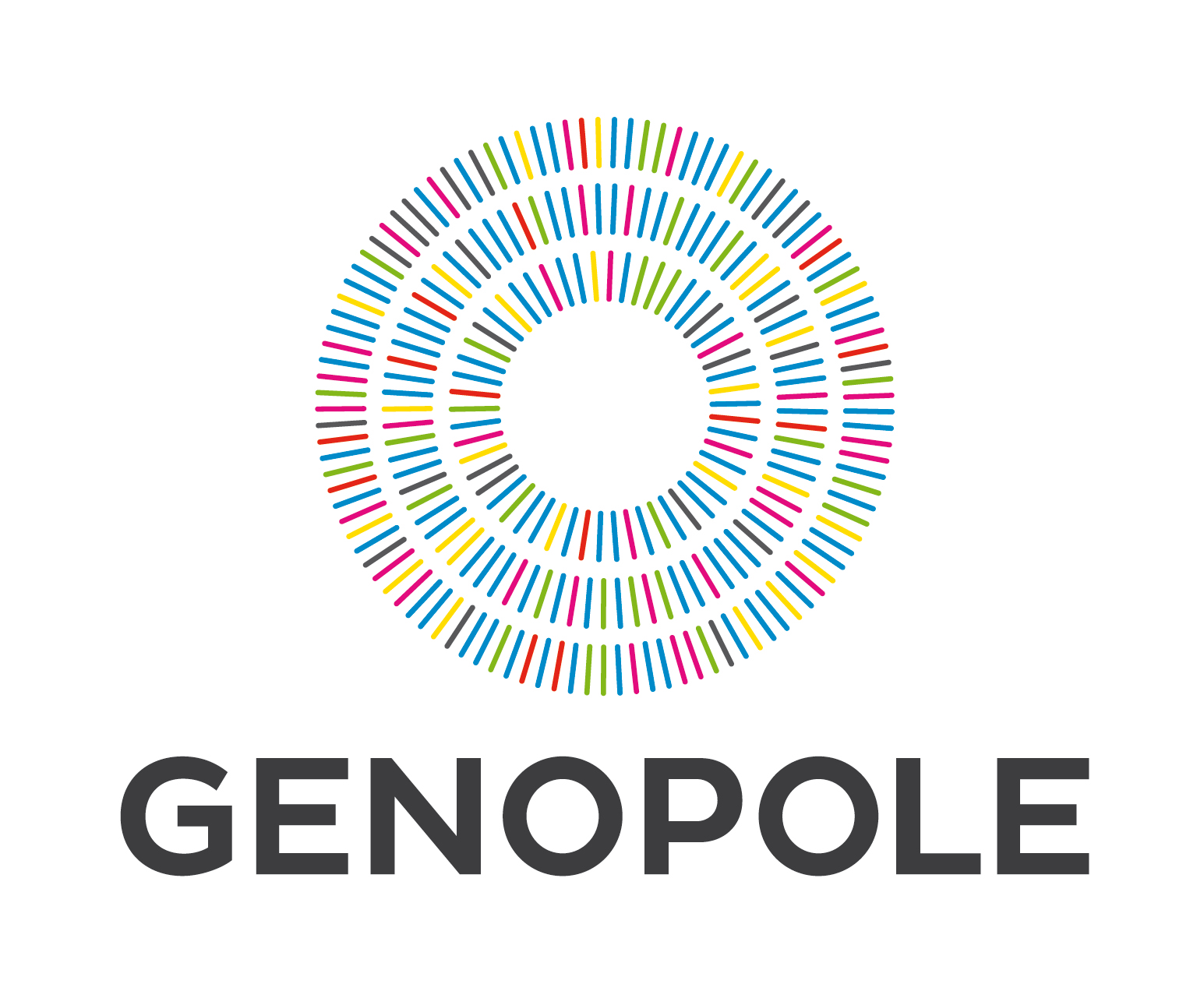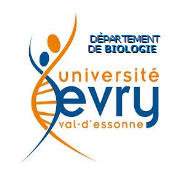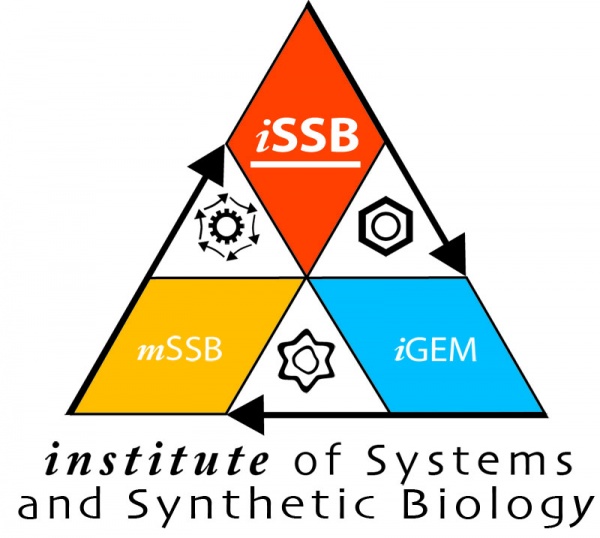Team:Evry/Seminar/vf
From 2013.igem.org
Séminaire sur l'hémochromatose le 18 Septembre
Le mercredi 18 septembre, nous avons organisé un séminaire sur l'hémochromatose au Génopole à Evry. Le but de ce séminaire était de présenter les dernières avancées scientifiques sur cette maladie ainsi que l'avenir de son traitement. Notre équipe a présenté la biologie synthétique et notre projet pour la compétition iGEM aux scientifiques et aux patients.
Programme de la journée
| Horaires | Intervenant | Sujet |
|---|---|---|
| 10:00-10:15 | Gabriel Guillocheau | Discours d'ouverture |
| 10:15-11:00 | Docteur Gaël Nicolas | Homéostasie du fer chez les mammifères et ses dérégulations |
| 11:00-11:45 | Professeur Pierre Brissot | L'hémochromatose : son diagnostic et son traitement |
| 12:00-12:45 | Docteur Marie-Paule Roth | Lien entre HFE, l'hepcidine et BMP6 |
| 14:15-15:00 | Présentation des résultats du questionnaire avec intervention de patients | |
| 15:00-15:45 | Nicolas Pollet | Le Microbiome |
| 16:00-16:45 | Equipe iGEM Evry Génopole | Présentation du projet de l'équipe |
| 16:45-17:00 | Gabriel Guillocheau | Discours de fermeture |
Report of the day
Gaël Nicolas: "Iron homeostasis in mammals and its deregulation"

Summary
Iron is necessary to living beings but potentially toxic, that is why homeostasis is required. In a human body there are 4 g to 5 g of iron, that is about a rusted nail. Iron is present as Fe2+ and Fe3+; as Fe3+ it is insoluble and thus must be degraded in Fe2+, but as Fe2+ it becomes highly toxic because it is a strong oxidant. Much of iron is located in the red blood cells. This explains why we associate iron with oxygen transport, but many other reactions imply iron.
In the 1930's, an experiment showed that iron was not excreted by the body: iron remains stocked in the body. Everyday we absorb 1 mg to 2 mg of iron in order to compensate the 1 mg to 2 mg of iron lost through the death of cells. The production of red blood cells daily uses 20 mg of iron, but these 20 mg exclusively come from the recycling process of old red blood cells by macrophages.
Hepcidin is a hormone that makes the level of iron in the serum decrease. Hepcidin is thus to iron approximatively what insulin is to glucose. Its deficiency is implied in almost all the forms of hemochromatosis. This hormone has three sulphur bridges, that makes it very difficult to synthesize.
Question/Answer
Q1: What are the consequences of iron overload on red blood cells? Are they not biconcave anymore?
A1: No, they remain biconcave because this feature has been naturally selected and it is necessary for the red blood cells to go through the capillaries. But there may be more of them, or they may be bigger.
Q2: Given the number of persons who have this disease, how is it still possible that doctors do not know it, or can not diagnose it properly?
How can you explain the different forms of the disease (particularly regarding the seriousness) between siblings?
A2: Other genes have effects on iron regulation, so they can increase or decrease the gravity of the disease. Food have consequences too, and for example the red wine contains much iron. Moreover alcohol reduces the production of hepcidin.
You mentioned doctors. I want to put things in perspective: in France there are around 200 000 doctors, and there are around 200 000 patients, thus a doctor will have on average one case in all his/her career.
Q3: According to you, will the synthetic mini-hepcidin induce an immune response?
A3: The mini-hepcidin is produced with major modifications, so yes.
Q4: Once iron is stored in organs, how can it be eliminated?
A4: It can not, unless by bloodletting.
Pierre Brissot: "Hemochromatosis: its diagnostic and its treatment"

Summary
Hemochromatosis is a frequent genetical disease: in France one person over 300 is predisposed to develop it. Indeed, it is a disease with an incomplete penetrance, which means that all the people who are homozygote for the mutation will not develop the disease. Hemochromatosis is also a delayed disease because the symptoms are long to appear: hemochromatosis is long silent. The first symptoms are chronic tiredness and rheumatism. As they are not very specific symptoms, 5 to 10 years often pass between their appearance and the diagnosis. The excessive accumulation of iron has serious consequences on the organs, mainly on the liver. The liver is indeed the first barrier of the body against iron. The over absorption of iron in the liver leads to its cirrhosis, and when the liver can no more stock iron, iron goes to the pancreas and the heart. The most usual genetic mutation causing hemochromatosis is a mutation of the “iron gene” on the chromosome 6, called C282Y homozygosity. This mutation drastically decrease the production of hepcidin. The genetic test should be done only after a blood test determining iron level. It is also possible to use MRI to see if the liver stocks iron. Bloodletting forces the organism to use the iron stocks to renew the red blood cells. Bloodletting gives really good results, almost without any side effect, but it is not perfect: for example rheumatism remains. Moreover some patients can not get used to bloodletting. Iron chelators (in oral treatment) can thus be an alternative to bloodletting, or at least complete bloodletting.
PDF of Pierre Brissot presentation (in french)Question/Answer
Q1: 98% of the patients have the mutation C282Y/C282Y. We know that this mutation is Celtic, but how can we explain the 2% who have another mutation?
A1: When we notice a major iron overload and a heterozygosity, we look for another mutation: sometimes it is indeed another mutation, but sometimes it is a heterozygosity with two different mutations of HFE gene (but it is very very rare).
We notice a great variety of symptoms, but the personal particularities are still uninterpretable.
Q2: What do we do with H63D patients?
A2: Nothing.
Q2': Even if their serum ferritin values reach 1200?
A2': The most frequent causes of high serum ferritin value are metabolic (alcohol, excess weight, etc.). The H63D patients are rarely iron overloaded.
Q3: Was the HFE mutation C282Y once an advantage?
A3: It was probably once a selective advantage against postpartum haemorrhage for example. But today it is no longer the case. A high amount of heterozygosity is often due to the fact that it was once a selective advantage.
Q4: Does the immune system age more quickly with frequent bloodletting? Has it been researched?
A4: No. But the life expectancy of an early diagnosed patient is average, even slightly above because hemochromatosis patients have a better medical follow-up. And iron overload is far more toxic than immune system aging.
Marie-Paule Roth: "Link between HFE, hepcidin and BMP6"

Summary
What are the pathways of Hepcidin regulation? So far, we know that a large number of proteins are involved in hepcidin synthesis, mainly BMP6, Hemojuvenile, ALK3 and SMAD4. The inactivation of one of these molecules leads to iron overload (this has been demonstrated in knockout mice). Studies on mice has revealed an important role of testosterone on the activation of EGF receptors, which are present in the liver and which is a repressor of hepcidin. In the biosynthesis cascade of hepcidin, the exact role of the HFE protein is still unclear but according to the current research hypotheses of Marie-Paul Roth's team, it seems it is involved in 2 pathways: One with BMP6 and one with BMP2.
PDF of Marie-Paule Roth presentation (in french)Question/Answer
Q1: How can we integrate the EGF way in the final model?
A1: I could have represented it, but we still do not know very well how it works. We need crossed mice to experiment.
Q2: Did you experiment on mice with KO Bmp6 type 2 receptors?
A2: No, because you can not invalidate those receptors without consequences, unless you only target the liver.
Result survey with patients participation

Summary
We learned three important informations with our survey.
Most patients are satisfied with bloodletting, and the more satisfied they are, the less they want another treatment. Despite this, they remain interested in a complementary treatment.
The most interested patients are the patients who would benefit the less from the bacterian treatment. Indeed this treatment would be most appropriate after the first phase of treatment, to help regulating iron absorption and diminishing the frequence of bloodletting.
Last but not least, our survey shows that a bacterian treatment would be a real help for working patients, who often have difficulties to leave their job to go to bloodletting.
Nicolas Pollet: "Microbiom studies"

Summary
All the micro-organisms that live in (and on) the human body constitute our microbiome. There are 10 times more of them than our own cells, and the microbiome as an all has 1000 times more genes than us. The microbiome is a necessary part of our organism, so there is a large number of beneficial bacterias.
The microbiome is still relatively unknown. We know that it is very complex. The number of micro-organisms increases exponentially along the digestive system; the microbiome varies depending on the place of the body, but also depending on the topology. Our microbiome changes during our live too: for example during pregnancy. Last but not least, we all have different microbiome, but it seems that there are several bacterial patterns. As the microbiome plays a role in some pathologies, these patterns may be a major research field.
Several probiotics are already marketed, and many more are tested.
Question/Answer
Q1: Concerning the probiotics, how can we avoid colonization?
A1: We remove all the plasmids involved in colonization.
Q2: Is there a dissemination risk, when the bacterias are evacuated in stools?
A2: No, they are anaerobic and without colonization power.
Q3: What about the risk of genetic information sharing?
A3: Bacterias share genetic informations continuously, so it is very unlikely that we increase the risks significantly.
iGEM EVRY team: "A bacterial treatment for hemochromatosis"

Summary
We ended the day by a presentation of our project. We first explain what synthetic biology and iGEM competition are, and described some famous achievements realized in this competition ( Austin 2004 Hello Word project, Edimburgh 2006 Arsenic Biosensor, Groningen 2012 Food Warden…).
We then presented our project, the reasons we chose it and how we designed our different systems: sensor, inverter and chelator systems. After that, we finished our presentation with some results we had obtained with the characterization of our iron sensing system and with our model.

Impréssions de quelques participants
Lorsque Gabriel Guillocheau m’a contacté au début de l’été pour participer à une réunion sur l’hémochromatose, j’ai bien perçu l’originalité et la pertinence de la démarche en cours.
Cette journée du 18 septembre 2013 a, de fait, pleinement confirmé cette première impression. J’ai plaisir à souligner les deux points qui m’ont paru les plus remarquables :
- L’originalité du projet scientifique visant, à partir de bactéries intestinales génétiquement orientées, à chélater le fer intestinal afin d’inhiber l’absorption duodénale du fer et ainsi contribuer à contrecarrer l’hyperabsorption digestive responsable du développement de la surcharge en fer, notamment au cours de l’hémochromatose génétique.
- L’audace et la performance dont a fait preuve le comité d’organisation, coordonné par Gabriel, pour -en seulement quelques semaines d’été- mettre sur pied une journée entière d’échanges faisant appel non seulement aux principaux experts nationaux médico-scientifiques dans le domaine mais aussi -attention et dimension particulières- aux principaux responsables des associations des patients atteints d’hémochromatose.
Je félicite donc chaleureusement toute l’équipe -juniors et encadrants- pour ce rendez-vous réussi. Et surtout tous mes vœux de succès dans la compétition internationale qui est à la source de cette journée du 18 septembre : vous avez, j’en suis convaincu, toutes vos chances !
Pr. Pierre Brissot
Cet évènement fût l'occasion de faire se rencontrer autour de l'hémochromatose, dans une ambiance extrèmement chaleureuse, des malades hémochromatosiques, des responsables d'associations de malades, des chercheurs et cliniciens experts dans le domaine de fer et l'équipe iGEM Evry 2013.
Au cours de la journée furent abordés des thèmes très variés : l'homéostasie du fer et les connaissances actuelles issues de la recherche fondamentale dans ce domaine, les aspects cliniques de l'hémochromatose, les aspects éthiques et philosophiques qui se posent quant à la création et l'utilisation d'un probiotique pour diminuer une surcharge en fer et enfin les dernières connaissances sur un sujet promis à un avenir exceptionnel : celui du microbiote (appelé microbiome pendant la journée). Sur l'initiative remarquable (et rare !) de l'iGEM Evry 2013, les malades ont eu l'occasion de s'exprimer sur leur maladie en répondant à un questionnaire : 134 femmes et 132 hommes ont répondu à ce questionnaire ce qui constitue une cohorte tout à fait remarquable. Une session présentée par l'iGEM Evry 2013 a été consacrée à l'analyse de quelques une des réponses du questionnaires. Enfin l'équipe iGEM Evry 2013 a présenté son projet. C'est à ce moment là qu'ils lous ont présenté un premier résultat intéressant validant le début d'une preuve de concept du projet : ils ont en effet réussi à obtenir une bactérie modifiée capable de moduler l'expression de la protéine GFP (Green Fluorescent Protein) en fonction de la quantité de fer présent dans le milieu de culture. La journée s'est terminée par une visite du laboratoire mis à disposition de l'iGEM Evry 2013 par Genopole pour monter leur projet.
Dans ce genre de journées il n'est pas si aisé d'avoir un vocabulaire adapté qui mette facilement la majorité des auditeurs sur le même niveau de connaissance, cela de façon à ce que les échanges soient les plus fructueux possibles. J'ai pourtant le sentiment que l'ensemble des orateurs a réussi l'exercice. De fait cela a permis, après chaque session, un ensemble de questions/réponses que j'ai trouvé très enrichissant.
D'un point de vue personnel il est toujours très enrichissant de rencontrer des malades, d'entendre leurs difficultés, de comprendre comment ils vivent, acceptent ou refusent certains aspects de leur maladie. C'est au cours de ces échanges que j'entends leur attente de nouveaux médicaments et qu'à mon tour je peux leur faire entendre qu'il est toujours très long entre une preuve de concept et l'obtention d'un nouveau traitement. Il est courant que dix à quinze années s'écoulent entre les deux.
Je renouvelle mes félicitations à l'ensemble des membres de l'iGEM Evry 2013 pour l'organisation de cette journée, leur dynamisme, leur audace scientifique et surtout pour la façon dont ils ont fait évoluer un projet tant sur le plan scientifique que phylosophique ... en partant de zéro ... et en un temps record de quelques mois !
Je souhaite profiter de l'occasion pour féliciter Genopole de soutenir de tels projets qui apporte une réelle innovation et une fraicheur dans la recherche.
Dr Gaël Nicolas
 "
"












